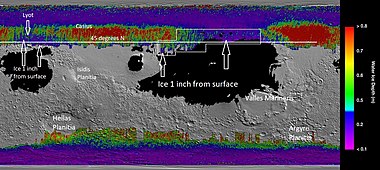Water on Mars
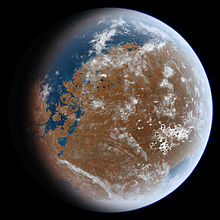
Almost all
Although the surface of Mars was periodically wet and could have been hospitable to microbial life billions of years ago,
Understanding the extent and situation of water on Mars is vital to assess the planet's potential for harboring life and for providing usable
Historical background
The notion of water on Mars preceded the
By the start of the 20th century, most astronomers recognized that Mars was far colder and drier than Earth. The presence of oceans was no longer accepted, so the paradigm changed to an image of Mars as a "dying" planet with only a meager amount of water. The dark areas, which could be seen to change seasonally, were then thought to be tracts of vegetation.[81] The person most responsible for popularizing this view of Mars was Percival Lowell (1855–1916), who imagined a race of Martians constructing a network of canals to bring water from the poles to the inhabitants at the equator. Although generating tremendous public enthusiasm, Lowell's ideas were rejected by most astronomers. The majority view of the scientific establishment at the time is probably best summarized by English astronomer Edward Walter Maunder (1851–1928) who compared the climate of Mars to conditions atop a twenty-thousand-foot (6,100 m) peak on an arctic island[82] where only lichen might be expected to survive.
In the meantime, many astronomers were refining the tool of planetary

The composition of the polar caps, assumed to be water ice since the time of Cassini (1666), was questioned by a few scientists in the late 1800s who favored CO2 ice, because of the planet's overall low temperature and apparent lack of appreciable water. This hypothesis was confirmed theoretically by Robert Leighton and Bruce Murray in 1966.[85] Today it is known that the winter caps at both poles are primarily composed of CO2 ice, but that a permanent (or perennial) cap of water ice remains during the summer at the northern pole. At the southern pole, a small cap of CO2 ice remains during summer, but this cap too is underlain by water ice.
The final piece of the Martian climate puzzle was provided by Mariner 4 in 1965. Grainy television pictures from the spacecraft showed a surface dominated by impact craters, which implied that the surface was very old and had not experienced the level of erosion and tectonic activity seen on Earth. Little erosion meant that liquid water had probably not played a large role in the planet's geomorphology for billions of years.[86] Furthermore, the variations in the radio signal from the spacecraft as it passed behind the planet allowed scientists to calculate the density of the atmosphere. The results showed an atmospheric pressure less than 1% of Earth's at sea level, effectively precluding the existence of liquid water, which would rapidly boil or freeze at such low pressures.[87] Thus, a vision of Mars was born of a world much like the Moon, but with just a wisp of an atmosphere to blow the dust around. This view of Mars would last nearly another decade until Mariner 9 showed a much more dynamic Mars with hints that the planet's past environment was more clement than the present one.
On January 24, 2014, NASA reported that
For many years it was thought that the observed remains of floods were caused by the release of water from a global water table, but research published in 2015 reveals regional deposits of sediment and ice emplaced 450 million years earlier to be the source.[91] "Deposition of sediment from rivers and glacial melt filled giant canyons beneath primordial ocean contained within the planet's northern lowlands. It was the water preserved in these canyon sediments that was later released as great floods, the effects of which can be seen today."[48][91]
Evidence from rocks and minerals
It is widely accepted that Mars had abundant water very early in its history,

Water in weathering products (aqueous minerals)
The primary rock type on the surface of Mars is
One direct effect of chemical weathering is to consume water and other reactive chemical species, taking them from mobile reservoirs like the atmosphere and hydrosphere and sequestering them in rocks and minerals.[99] The amount of water in the Martian crust stored as hydrated minerals is currently unknown, but may be quite large.[100] For example, mineralogical models of the rock outcroppings examined by instruments on the Opportunity rover at Meridiani Planum suggest that the sulfate deposits there could contain up to 22% water by weight.[101]
On Earth, all chemical weathering reactions involve water to some degree. The extent to which such exotic weathering processes operate on Mars is still uncertain. Minerals that incorporate water or form in the presence of water are generally termed "aqueous minerals".
Aqueous minerals are sensitive indicators of the type of environment that existed when the minerals formed. The ease with which aqueous reactions occur (see Gibbs free energy) depends on the pressure, temperature, and on the concentrations of the gaseous and soluble species involved.[105] Two important properties are pH and oxidation-reduction potential (Eh). For example, the sulfate mineral jarosite forms only in low pH (highly acidic) water. Phyllosilicates usually form in water of neutral to high pH (alkaline). Eh is a measure of the oxidation state of an aqueous system. Together Eh and pH indicate the types of minerals that are thermodynamically most stable and therefore most likely to form from a given set of aqueous components. Thus, past environmental conditions on Mars, including those conducive to life, can be inferred from the types of minerals present in the rocks.
Hydrothermal alteration
Aqueous minerals can also form in the subsurface by
Weathering rates
The rates at which primary minerals convert to secondary aqueous minerals vary. Primary silicate minerals crystallize from magma under pressures and temperatures vastly higher than conditions at the surface of a planet. When exposed to a surface environment these minerals are out of
Martian meteorites
Over 60 meteorites have been found that came from Mars.[117] Some of them contain evidence that they were exposed to water when on Mars. Some Martian meteorites called basaltic shergottites, appear (from the presence of hydrated carbonates and sulfates) to have been exposed to liquid water prior to ejection into space.[118][119] It has been shown that another class of meteorites, the nakhlites, were suffused with liquid water around 620 million years ago and that they were ejected from Mars around 10.75 million years ago by an asteroid impact. They fell to Earth within the last 10,000 years.[120] Martian meteorite NWA 7034 has one order of magnitude more water than most other Martian meteorites. It is similar to the basalts studied by rover missions, and it was formed in the early Amazonian epoch.[121][122]
In 1996, a group of scientists reported the possible presence of microfossils in the Allan Hills 84001, a meteorite from Mars.[123] Many studies disputed the validity of their interpretation mainly based on the shape of these presumed fossils.[124][125] It was found that most of the organic matter in the meteorite was of terrestrial origin.[126] In addition, the scientific consensus is that "morphology alone cannot be used unambiguously as a tool for primitive life detection".[127][128][129] Interpretation of morphology is notoriously subjective, and its use alone has led to numerous errors of interpretation.[127]
Geomorphic evidence
Lakes and river valleys
The 1971

Some parts of Mars show

A variety of lake basins have been discovered on Mars.
Research from 2010 suggests that Mars also had lakes along parts of the equator. Although earlier research had showed that Mars had a warm and wet early history that has long since dried up, these lakes existed in the Hesperian Epoch, a much later period. Using detailed images from NASA's Mars Reconnaissance Orbiter, the researchers speculate that there may have been increased volcanic activity, meteorite impacts or shifts in Mars' orbit during this period to warm Mars' atmosphere enough to melt the abundant ice present in the ground. Volcanoes would have released gases that thickened the atmosphere for a temporary period, trapping more sunlight and making it warm enough for liquid water to exist. In this study, channels were discovered that connected lake basins near Ares Vallis. When one lake filled up, its waters overflowed the banks and carved the channels to a lower area where another lake would form.[147][148] These dry lakes would be targets to look for evidence (biosignatures) of past life.
On September 27, 2012, NASA scientists announced that the
-
Map showing estimated water depth in different parts of Eridania Sea.
This map is about 530 miles across. -
Deep-basin deposits from the floor of Eridania Sea. The mesas on the floor are there because they were protected against intense erosion by deep water/ice cover.CRISMmeasurements show minerals may be from seafloor hydrothermal deposits.
-
Diagram showing how volcanic activity may have caused deposition of minerals on floor of Eridania Sea. Chlorides were deposited along the shoreline by evaporation.
Lake deltas
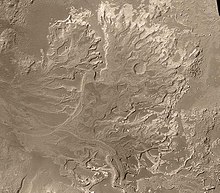
Researchers have found a number of examples of deltas that formed in Martian lakes.[34] Finding deltas is a major sign that Mars once had a lot of liquid water. Deltas usually require deep water over a long period of time to form. Also, the water level needs to be stable to keep sediment from washing away. Deltas have been found over a wide geographical range,[52] though there is some indication that deltas may be concentrated around the edges of the putative former northern ocean of Mars.[161]
Groundwater

By 1979 it was thought that
The branching

In February 2019, European scientists published geological evidence of an ancient planet-wide groundwater system that was, arguably, connected to a putative vast ocean.[178][179][180][181] In September 2019, researchers reported that the InSight lander uncovered unexplained magnetic pulses, and magnetic oscillations consistent with a planet-wide reservoir of liquid water deep underground.[182]
Mars ocean hypothesis
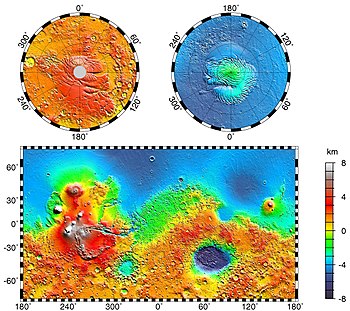
The Mars ocean hypothesis proposes that the
A study in June 2010 concluded that the more ancient ocean would have covered 36% of Mars.[34][35] Data from the Mars Orbiter Laser Altimeter (MOLA), which measures the altitude of all terrain on Mars, was used in 1999 to determine that the watershed for such an ocean would have covered about 75% of the planet.[185] Early Mars would have required a warmer climate and denser atmosphere to allow liquid water to exist at the surface.[186][187] In addition, the large number of valley networks strongly supports the possibility of a hydrological cycle on the planet in the past.[171][188]
The existence of a primordial Martian ocean remains controversial among scientists, and the interpretations of some features as 'ancient shorelines' has been challenged.
In March 2015, scientists stated that evidence exists for an ancient Martian ocean, likely in the planet's northern hemisphere and about the size of Earth's
Additional evidence for a northern ocean was published in May 2016, describing how some of the surface in Ismenius Lacus quadrangle was altered by two tsunamis. The tsunamis were caused by asteroids striking the ocean. Both were thought to have been strong enough to create 30 km diameter craters. The first tsunami picked up and carried boulders the size of cars or small houses. The backwash from the wave formed channels by rearranging the boulders. The second came in when the ocean was 300 m lower. The second carried a great deal of ice which was dropped in valleys. Calculations show that the average height of the waves would have been 50 m, but the heights would vary from 10 m to 120 m. Numerical simulations show that in this particular part of the ocean two impact craters of the size of 30 km in diameter would form every 30 million years. The implication here is that a great northern ocean may have existed for millions of years. One argument against an ocean has been the lack of shoreline features. These features may have been washed away by these tsunami events. The parts of Mars studied in this research are Chryse Planitia and northwestern Arabia Terra. These tsunamis affected some surfaces in the Ismenius Lacus quadrangle and in the Mare Acidalium quadrangle.[193][194][195]
In July 2019, support was reported for an
In January 2022, a study about the climate 3 Gy ago on Mars shows that an ocean is stable with a water cycle that is closed.[198] They estimate a return water flow, in form of ice in glacier, from the icy highlands to the ocean is in magnitude less than the Earth at the last glacial maximum. This simulation includes for the first time a circulatin of the ocean. They demonstrate that the ocean's circulation prevent the ocean to freeze. These also shows that simulations are in agreement with observed geomorphological features identified as ancient glacial valleys.
Evidence for recent flows
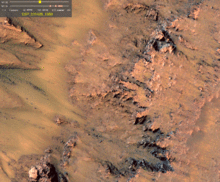


Pure liquid water cannot exist in a stable form on the surface of Mars with its present low atmospheric pressure and low temperature because it would boil, except at the lowest elevations for a few hours.
There is disagreement in the scientific community as to whether or not gullies are formed by liquid water. While some scientists believe that most gullies are formed by liquid water formed from snow or ice melting,[206][207][208] other scientists believe that gullies are formed by dry flows possibly lubricated by sublimating carbon dioxide that forms from freezing of the martian atmosphere.[209][210][211]
Some studies attest that gullies forming in the southern highlands could not be formed by water due to improper conditions. The low pressure, non-geothermal, colder regions would not give way to liquid water at any point in the year but would be ideal for solid carbon dioxide. The carbon dioxide melting in the warmer summer would yield liquid carbon dioxide which would then form the gullies.[212][213] Even if gullies are carved by flowing water at the surface, the exact source of the water and the mechanisms behind its motion are not understood.[214]
In August 2011, NASA announced the discovery of current seasonal changes on steep slopes below rocky outcrops near crater rims in the Southern hemisphere. These dark streaks, now called
An alternative scenario is a Knudsen pump effect, from photophoretic when shadows occurs in a granular material.[222] The authors demonstrated that the RSLs stopped at an angle of 28° in Garni crater, in agreement with dry granular avalanche. In addition, the authors pointed out several limitations of the wet hypothesis, such as the fact that the detection of water was only indirect (salt detection but not water).
Present water
A significant amount of surface
The Mars Odyssey neutron spectrometer observations indicate that if all the ice in the top meter of the Martian surface were spread evenly, it would give a Water Equivalent Global layer (WEG) of at least ≈14 centimetres (5.5 in)—in other words, the globally averaged Martian surface is approximately 14% water.[226] The water ice currently locked in both Martian poles corresponds to a WEG of 30 metres (98 ft), and geomorphic evidence favors significantly larger quantities of surface water over geologic history, with WEG as deep as 500 metres (1,600 ft).[13][226] It is thought that part of this past water has been lost to the deep subsurface, and part to space, although the detailed mass balance of these processes remains poorly understood.[144] The current atmospheric reservoir of water is important as a conduit allowing gradual migration of ice from one part of the surface to another on both seasonal and longer timescales, but it is insignificant in volume, with a WEG of no more than 10 micrometres (0.00039 in).[226]
It is possible that liquid water could also exist on the surface of Mars through the formation of
Polar ice caps
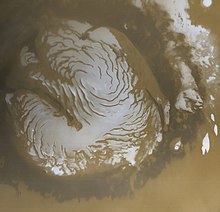

The existence of ice in the Martian northern (Planum Boreum) and southern (Planum Australe) polar caps has been known since the time of Mariner 9 orbiter.[235] However, the amount and purity of this ice were not known until the early 2000s. In 2004, the MARSIS radar sounder on the European Mars Express satellite confirmed the existence of relatively clean ice in the south polar ice cap that extends to a depth of 3.7 kilometres (2.3 mi) below the surface.[236][237] Similarly, the SHARAD radar sounder on board the Mars Reconnaissance Orbiter observed the base of the north polar cap 1.5 – 2 km beneath the surface. Together, the volume of ice present in the Martian north and south polar ice caps is similar to that of the Greenland ice sheet.[238]

An even larger ice sheet on south polar region sheet is suspected to have retreated in ancient times (Hesperian period), that may have contained 20 million km3 of water ice, which is equivalent to a layer 137 m deep over the entire planet.[239][240]
Both polar caps reveal abundant internal layers of ice and dust when examined with images of the spiral-shaped troughs that cut through their volume, and the subsurface radar measurements showed that these layers extend continuously across the ice sheets. This layering contains a record of past climates on Mars, just how Earth's ice sheets have a record for Earth's climate. Reading this record is not straightforward however,[241] so, many researchers have studied this layering not only to understand the structure, history, and flow properties of the caps,[144] but also to understand the evolution of climate on Mars.[242][243]
Surrounding the polar caps are many smaller ice sheets inside craters, some of which lie under thick deposits of sand or martian dust.[244][245] Particularly, the 81.4 kilometres (50.6 mi) wide Korolev Crater, is estimated to contain approximately 2,200 cubic kilometres (530 cu mi) of water ice exposed to the surface.[246] Korolev's floor lies about 2 kilometres (1.2 mi) below the rim, and is covered by a 1.8 kilometres (1.1 mi) deep central mound of permanent water ice, up to 60 kilometres (37 mi) in diameter.[246][247]
Subglacial liquid water

The existence of subglacial lakes on Mars was hypothesised when modelling of Lake Vostok in Antarctica showed that this lake could have existed before the Antarctic glaciation, and that a similar scenario could potentially have occurred on Mars.[248] In July 2018, scientists from the Italian Space Agency reported the detection of such a subglacial lake on Mars, 1.5 kilometres (1 mi) below the southern polar ice cap, and spanning 20 kilometres (10 mi) horizontally, the first evidence for a stable body of liquid water on the planet.[69][249][250][251] The evidence for this Martian lake was deduced from a bright spot in the radar echo sounding data of the MARSIS radar on board the European Mars Express orbiter,[252] collected between May 2012 and December 2015. The detected lake is centred at 193°E, 81°S, a flat area that does not exhibit any peculiar topographic characteristics but is surrounded by higher ground, except on its eastern side where there is a depression.[69] The SHARAD radar on board NASA's Mars Reconnaissance Orbiter has seen no sign of the lake. The operating frequencies of SHARAD are designed for higher resolution, but lower penetration depth, so if the overlying ice contains a significant amount of silicates, it is unlikely that SHARAD will be able to detect the putative lake.
On 28 September 2020, the MARSIS discovery was confirmed, using new data, and reanalysing all the data with a new technique. These new radar studies report three more subglacial lakes on Mars. All are 1.5 km (0.93 mi) below the southern polar ice cap. The size of the first lake found, and the largest, has been corrected to 30 km (19 mi) wide. It is surrounded by 3 smaller lakes, each a few kilometres wide.[253]

Because the temperature at the base of the polar cap is estimated to be 205 K (−68 °C; −91 °F), scientists assume that the water may remain liquid through the antifreeze effect of magnesium and calcium perchlorates.[69][254] The 1.5-kilometre (0.93 mi) ice layer covering the lake is composed of water ice with 10 to 20% admixed dust, and seasonally covered by a 1-metre-thick (3 ft 3 in) layer of CO2 ice.[69] Since the raw-data coverage of the south polar ice cap is limited, the discoverers stated that "there is no reason to conclude that the presence of subsurface water on Mars is limited to a single location."[69]
In 2019, a study was published that explored the physical conditions necessary for such a lake to exist.[255] The study calculated the amount of geothermal heat necessary to reach temperatures under which a liquid water and perchlorate mix would be stable under the ice. The authors concluded that "even if there are local concentrations of large amounts of perchlorate salts at the base of the south polar ice, typical Martian conditions are too cold to melt the ice ... a local heat source within the crust is needed to increase the temperatures, and a magma chamber within 10 km of the ice could provide such a heat source. This result suggests that if the liquid water interpretation of the observations is correct, magmatism on Mars may have been active extremely recently."
China's Zhurong rover that studied Utopia Planitia region of Mars found a shift in sand dunes at around the same time as layers in the North polar region changed. Researchers believe that the tilt of Mars changed at that time and produced changes in the winds at Zhurong's landing site and in the layers in the ice cap.[256]
If a liquid lake does indeed exist, its salty water may also be mixed with soil to form a sludge.[257] The lake's high levels of salt would present difficulties for most lifeforms. On Earth, organisms called halophiles exist that thrive in extremely salty conditions, though not in dark, cold, concentrated perchlorate solutions.[257] Nevertheless, halotolerant organisms might be able to cope with enhanced perchlorate concentrations by drawing on physiological adaptations similar to those observed in the yeast Debaryomyces hansenii exposed in lab experiments to increasing NaClO4 concentrations.[258]
Ground ice
For many years, various scientists have suggested that some Martian surfaces look like
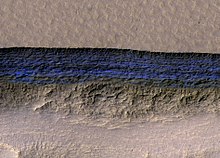
In 2017, using the HiRISE camera on board the Mars Reconnaissance Orbiter (MRO), researchers found at least eight eroding slopes showing exposed water ice sheets as thick as 100 meters, covered by a layer of about 1 or 2 meters thick of soil.[264][266] The sites are at latitudes from about 55 to 58 degrees, suggesting that there is shallow ground ice under roughly a third of the Martian surface.[264] This image confirms what was previously detected with the spectrometer on 2001 Mars Odyssey, the ground-penetrating radars on MRO and on Mars Express, and by the Phoenix lander in situ excavation.[264] These ice layers hold easily accessible clues about Mars' climate history and make frozen water accessible to future robotic or human explorers.[264] Some researchers suggested these deposits could be the remnants of glaciers that existed millions of years ago when the planet's spin axis and orbit were different. (See section Mars' Ice ages below.) A more detailed study published in 2019 discovered that water ice exists at latitudes north of 35°N and south of 45°S, with some ice patches only a few centimeters from the surface covered by dust. Extraction of water ice at these conditions would not require complex equipment.[267][268]
-
Ice disappearing after being exposed by impact.
-
Close view of wall of triangular depression, as seen by HiRISE layers are visible in the wall. These layers contain ice. The lower layers are tilted, while layers near the surface are more or less horizontal. Such an arrangement of layers is called an "angular unconformity".[269][full citation needed]
-
Impact crater that may have formed in ice-rich ground, as seen by HiRISE under HiWish program Location is the Ismenius Lacus quadrangle.
-
Close view of impact crater that may have formed in ice-rich ground, as seen by HiRISE under HiWish program. Note that the ejecta seems lower than the surroundings. The hot ejecta may have caused some of the ice to go away, thus lowering the level of the ejecta.
-
Map of near surface ice
Scalloped topography
Certain regions of Mars display scalloped-shaped depressions. The depressions are suspected to be the remains of a degrading ice-rich mantle deposit. Scallops are caused by ice sublimating from frozen soil. The landforms of scalloped topography can be formed by the subsurface loss of water ice by sublimation under current Martian climate conditions. A model predicts similar shapes when the ground has large amounts of pure ice, up to many tens of meters in depth.[270] This mantle material was probably deposited from the atmosphere as ice formed on dust when the climate was different due to changes in the tilt of the Mars pole (see § Ice ages, below).[271][272][273] The scallops are typically tens of meters deep and from a few hundred to a few thousand meters across. They can be almost circular or elongated. Some appear to have coalesced causing a large heavily pitted terrain to form. The process of forming the terrain may begin with sublimation from a crack. There are often polygonal cracks where scallops form, and the presence of scalloped topography seems to be an indication of frozen ground.[141][263]
On November 22, 2016, NASA reported finding a large amount of underground ice in the Utopia Planitia region of Mars.[274] The volume of water detected has been estimated to be equivalent to the volume of water in Lake Superior.[2][3][4]
The volume of water ice in the region were based on measurements from the ground-penetrating radar instrument on
These scalloped features are superficially similar to Swiss cheese features, found around the south polar cap. Swiss cheese features are thought to be due to cavities forming in a surface layer of solid carbon dioxide, rather than water ice—although the floors of these holes are probably H2O-rich.[278]
Ice patches

On July 28, 2005, the European Space Agency announced the existence of a crater partially filled with frozen water;[279] some then interpreted the discovery as an "ice lake".[280] Images of the crater, taken by the High Resolution Stereo Camera on board the European Space Agency's Mars Express orbiter, clearly show a broad sheet of ice in the bottom of an unnamed crater located on Vastitas Borealis, a broad plain that covers much of Mars' far northern latitudes, at approximately 70.5° North and 103° East. The crater is 35 kilometres (22 mi) wide and about 2 kilometres (1.2 mi) deep. The height difference between the crater floor and the surface of the water ice is about 200 metres (660 ft). ESA scientists have attributed most of this height difference to sand dunes beneath the water ice, which are partially visible. While scientists do not refer to the patch as a "lake", the water ice patch is remarkable for its size and for being present throughout the year. Deposits of water ice and layers of frost have been found in many different locations on the planet.
As more and more of the surface of Mars has been imaged by the modern generation of orbiters, it has become gradually more apparent that there are probably many more patches of ice scattered across the Martian surface. Many of these putative patches of ice are concentrated in the Martian mid-latitudes (≈30–60° N/S of the equator). For example, many scientists think that the widespread features in those latitude bands variously described as "latitude dependent mantle" or "pasted-on terrain" consist of dust- or debris-covered ice patches, which are slowly degrading.
Surface features consistent with existing
Glaciers

Many large areas of Mars either appear to host glaciers, or carry evidence that they used to be present. Much of the areas in high latitudes, especially the

Glacier-like features on Mars are known variously as viscous flow features,[290] Martian flow features, lobate debris aprons,[62] or lineated valley fill,[58] depending on the form of the feature, its location, the landforms it is associated with, and the author describing it. Many, but not all, small glaciers seem to be associated with gullies on the walls of craters and mantling material.[291] The lineated deposits known as lineated valley fill are probably rock-covered glaciers that are found on the floors of most channels within the fretted terrain found around Arabia Terra in the northern hemisphere. Their surfaces have ridged and grooved materials that deflect around obstacles. Lineated floor deposits may be related to lobate debris aprons, which have been proven to contain large amounts of ice by orbiting radar.[45][62] For many years, researchers interpreted that features called 'lobate debris aprons' were glacial flows and it was thought that ice existed under a layer of insulating rocks.[61][292][293] With new instrument readings, it has been confirmed that lobate debris aprons contain almost pure ice that is covered with a layer of rocks.[45][62]

Moving ice carries rock material, then drops it as the ice disappears. This typically happens at the snout or edges of the glacier. On Earth, such features would be called
Despite strong evidence for glacial flow on Mars, there is little convincing evidence for
Development of Mars' water inventory
The variation in Mars's surface water content is strongly coupled to the evolution of its atmosphere and may have been marked by several key stages. Head and others put together a detailed history of water on Mars and presented it in March, 2023.[297]
Early Noachian era (4.6 Ga to 4.1 Ga)
The early Noachian era was characterized by atmospheric loss to space from heavy meteoritic bombardment and hydrodynamic escape.
Middle to late Noachean era (4.1 Ga to 3.8 Ga)
During the middle to late Noachean era, Mars underwent potential formation of a
Hesperian to Amazonian era (present) (~3.8 Ga to present)
Atmospheric enhancement by sporadic outgassing events were countered by solar wind stripping of the atmosphere, albeit less intensely than by the young Sun.[299] Catastrophic floods date to this period, favoring sudden subterranean release of volatiles, as opposed to sustained surface flows.[298] While the earlier portion of this era may have been marked by aqueous acidic environments and Tharsis-centric groundwater discharge[302] dating to the late Noachian, much of the surface alteration processes during the latter portion is marked by oxidative processes including the formation of Fe3+ oxides that impart a reddish hue to the Martian surface.[299] Such oxidation of primary mineral phases can be achieved by low-pH (and possibly high temperature) processes related to the formation of palagonitic tephra,[303] by the action of H2O2 that forms photochemically in the Martian atmosphere,[304] and by the action of water,[300] none of which require free O2. The action of H2O2 may have dominated temporally given the drastic reduction in aqueous and igneous activity in this recent era, making the observed Fe3+ oxides volumetrically small, though pervasive and spectrally dominant.[305] Nevertheless, aquifers may have driven sustained, but highly localized surface water in recent geologic history, as evident in the geomorphology of craters such as Mojave.[306] Furthermore, the Lafayette Martian meteorite shows evidence of aqueous alteration as recently as 650 Ma.[298]

In 2020 scientists reported that Mars' current loss of atomic hydrogen from water is largely driven by seasonal processes and dust storms that transport water directly to the upper atmosphere and that this has influenced the planet's climate likely during the last 1 Ga.[307][308] More recent studies have suggested that upward propagating atmospheric gravity waves can play an important role during global dust storms in modulating water escape.[309][310]
Ice ages
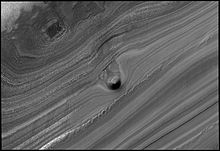
Mars has experienced about 40 large scale changes in the amount and distribution of ice on its surface over the past five million years,
The moisture from the ice caps travels to lower latitudes in the form of deposits of frost or snow mixed with dust. The atmosphere of Mars contains a great deal of fine dust particles, the water vapor condenses on these particles that then fall down to the ground due to the additional weight of the water coating. When ice at the top of the mantling layer returns to the atmosphere, it leaves behind dust that serves to insulate the remaining ice.[316] The total volume of water removed is a few percent of the ice caps, or enough to cover the entire surface of the planet under one meter of water. Much of this moisture from the ice caps results in a thick smooth mantle with a mixture of ice and dust.[271][272][318][319] This ice-rich mantle, that can be 100 meters thick at mid-latitudes,[320] smoothes the land at lower latitudes, but in places it displays a bumpy texture or patterns that give away the presence of former water ice underneath.
Habitability assessments
Since the Viking landers that searched for current microbial life in 1976, NASA has pursued a "follow the water" strategy on Mars. However, liquid water is a necessary but not sufficient condition for life as we know it because habitability is a function of a multitude of environmental parameters.[321] Chemical, physical, geological, and geographic attributes shape the environments on Mars. Isolated measurements of these factors may be insufficient to deem an environment habitable, but the sum of measurements can help predict locations with greater or lesser habitability potential.[322]
Habitable environments need not be inhabited, and for purposes of planetary protection, scientists are trying to identify potential habitats where stowaway bacteria from Earth on spacecraft could contaminate Mars.[323] If life exists—or existed—on Mars, evidence or biosignatures could be found in the subsurface, away from present-day harsh surface conditions such as perchlorates,[324][325] ionizing radiation, desiccation and freezing.[326] Habitable locations could occur kilometers below the surface in a hypothetical hydrosphere, or it could occur near the sub-surface in contact with permafrost.[64][65][66][67][68]
The Curiosity rover is assessing Mars' past and present habitability potential. The European-Russian
Findings by probes
Mariner 9

The images acquired by the Mariner 9 Mars orbiter, launched in 1971, revealed the first direct evidence of past water in the form of dry river beds, canyons (including the Valles Marineris, a system of canyons over about 4,020 kilometres (2,500 mi) long), evidence of water erosion and deposition, weather fronts, fogs, and more.[327] The findings from the Mariner 9 missions underpinned the later Viking program. The enormous Valles Marineris canyon system is named after Mariner 9 in honor of its achievements.
Viking program

By discovering many geological forms that are typically formed from large amounts of water, the two
Mars Global Surveyor

The

Mars Pathfinder
The Pathfinder lander recorded the variation of diurnal temperature cycle. It was coldest just before sunrise, about −78 °C (−108 °F; 195 K), and warmest just after Mars noon, about −8 °C (18 °F; 265 K). At this location, the highest temperature never reached the freezing point of water (0 °C (32 °F; 273 K)), too cold for pure liquid water to exist on the surface.
The atmospheric pressure measured by the Pathfinder on Mars is very low —about 0.6% of Earth's, and it would not permit pure liquid water to exist on the surface.[337]
Other observations were consistent with water being present in the past. Some of the rocks at the Mars Pathfinder site leaned against each other in a manner geologists term imbricated. It is suspected that strong flood waters in the past pushed the rocks around until they faced away from the flow. Some pebbles were rounded, perhaps from being tumbled in a stream. Parts of the ground are crusty, maybe due to cementing by a fluid containing minerals.[338] There was evidence of clouds and maybe fog.[338]
Mars Odyssey
The

The instruments aboard the Mars Odyssey are able to study the top meter of soil. In 2002, available data were used to calculate that if all soil surfaces were covered by an even layer of water, this would correspond to a global layer of water (GLW) 0.5–1.5 kilometres (0.31–0.93 mi).[345]
Thousands of images returned from Odyssey orbiter also support the idea that Mars once had great amounts of water flowing across its surface. Some images show patterns of branching valleys; others show layers that may have been formed under lakes; even river and lake deltas have been identified.[52][346] For many years researchers suspected that glaciers exist under a layer of insulating rocks.[45][61][62] Lineated valley fill is one example of these rock-covered glaciers. They are found on the floors of some channels. Their surfaces have ridged and grooved materials that deflect around obstacles. Lineated floor deposits may be related to lobate debris aprons, which have been shown by orbiting radar to contain large amounts of ice.[45][62]
Phoenix

The Phoenix lander also confirmed the existence of large amounts of water ice in the northern region of Mars.[347][348] This finding was predicted by previous orbital data and theory,[349] and was measured from orbit by the Mars Odyssey instruments.[340] On June 19, 2008, NASA announced that dice-sized clumps of bright material in the "Dodo-Goldilocks" trench, dug by the robotic arm, had vaporized over the course of four days, strongly indicating that the bright clumps were composed of water ice that sublimes following exposure. Recent radiative transfer modeling has shown that this water ice was snow with a grain size of ~350 µm with 0.015% dust.[350] Even though CO2 (dry ice) also sublimes under the conditions present, it would do so at a rate much faster than observed.[351] On July 31, 2008, NASA announced that Phoenix further confirmed the presence of water ice at its landing site. During the initial heating cycle of a sample, the mass spectrometer detected water vapor when the sample temperature reached 0 °C (32 °F; 273 K).[352] Stable liquid water cannot exist on the surface of Mars with its present low atmospheric pressure and temperature (it would boil), except at the lowest elevations for short periods.[200][201][347][353]
The presence of the perchlorate (ClO4–) anion, a strong oxidizer, in the martian soil was confirmed. This salt can considerably lower the water freezing point.

When Phoenix landed, the
For about as far as the camera can see, the landing site is flat, but shaped into polygons between 2–3 metres (6 ft 7 in – 9 ft 10 in) in diameter which are bounded by troughs that are 20–50 centimetres (7.9–19.7 in) deep. These shapes are due to ice in the soil expanding and contracting due to major temperature changes. The microscope showed that the soil on top of the polygons is composed of rounded particles and flat particles, probably a type of clay.[360] Ice is present a few inches below the surface in the middle of the polygons, and along its edges, the ice is at least 8 inches (200 mm) deep.[353]
Snow was observed to fall from cirrus clouds. The clouds formed at a level in the atmosphere that was around −65 °C (−85 °F; 208 K), so the clouds would have to be composed of water-ice, rather than carbon dioxide-ice (CO2 or dry ice), because the temperature for forming carbon dioxide ice is much lower than −120 °C (−184 °F; 153 K). As a result of mission observations, it is now suspected that water ice (snow) would have accumulated later in the year at this location.[361] The highest temperature measured during the mission, which took place during the Martian summer, was −19.6 °C (−3.3 °F; 253.6 K), while the coldest was −97.7 °C (−143.9 °F; 175.5 K). So, in this region the temperature remained far below the freezing point (0 °C (32 °F; 273 K)) of water.[362]
Mars Exploration Rovers




The
As Spirit traveled in reverse in December 2007, pulling a seized wheel behind, the wheel scraped off the upper layer of soil, uncovering a patch of white ground rich in
The
The MER rovers found evidence for ancient wet environments that were very acidic. In fact, what Opportunity found evidence of sulfuric acid, a harsh chemical for life.[46][47][375][376] But on May 17, 2013, NASA announced that Opportunity found clay deposits that typically form in wet environments that are near neutral acidity. This find provides additional evidence about a wet ancient environment possibly favorable for life.[46][47]
Mars Reconnaissance Orbiter
The Mars Reconnaissance Orbiter's HiRISE instrument has taken many images that strongly suggest that Mars has had a rich history of water-related processes. A major discovery was finding evidence of ancient hot springs. If they have hosted microbial life, they may contain biosignatures.[377] Research published in January 2010, described strong evidence for sustained precipitation in the area around Valles Marineris.[140][141] The types of minerals there are associated with water. Also, the high density of small branching channels indicates a great deal of precipitation.
Rocks on Mars have been found to frequently occur as layers, called strata, in many different places.[378] Layers form by various ways, including volcanoes, wind, or water.[379] Light-toned rocks on Mars have been associated with hydrated minerals like sulfates and clay.[380]

The orbiter helped scientists determine that much of the surface of Mars is covered by a thick smooth mantle that is thought to be a mixture of ice and dust.[272][381][382]
The ice mantle under the shallow subsurface is thought to result from frequent, major climate changes. Changes in Mars' orbit and tilt cause significant changes in the distribution of water ice from polar regions down to latitudes equivalent to Texas. During certain climate periods water vapor leaves polar ice and enters the atmosphere. The water returns to the ground at lower latitudes as deposits of frost or snow mixed generously with dust. The atmosphere of Mars contains a great deal of fine dust particles.[203] Water vapor condenses on the particles, then they fall down to the ground due to the additional weight of the water coating. When ice at the top of the mantling layer goes back into the atmosphere, it leaves behind dust, which insulates the remaining ice.[316]
In 2008, research with the Shallow Radar on the Mars Reconnaissance Orbiter provided strong evidence that the
Research published in September 2009, demonstrated that some new craters on Mars show exposed, pure water ice.[383] After a time, the ice disappears, evaporating into the atmosphere. The ice is only a few feet deep. The ice was confirmed with the Compact Imaging Spectrometer (CRISM) on board the Mars Reconnaissance Orbiter.[384] Similar exposures of ice have been detected within the mid-latitude mantle (originally proposed to contain buried dusty snow covered with dust and regolith;[271]) that drapes most pole-facing slopes in the mid-latitudes using spectral analysis of HiRISE images.[385]
Additional collaborating reports published in 2019 evaluated the amount of water ice located at the northern pole. One report used data from the MRO's SHARAD (SHAllow RADar sounder) probes. SHARAD has the capability scanning up to about 2 kilometres (1.2 mi) below the surface at 15 metres (49 ft) intervals. The analysis of past SHARAD runs showed evidence of strata of water ice and sand below the Planum Boreum, with as much as 60% to 88% of the volume being water ice. This supports the theory of the long-term global weather of Mars consisting of cycles of global warming and cooling; during cooling periods, water gathered at the poles to form the ice layers, and then as global warming occurred, the unthawed water ice was covered by dust and dirt from Mars' frequent dust storms. The total ice volume determine by this study indicated that there was approximately 2.2×105 cubic kilometres (5.3×104 cu mi), or enough water, if melted, to fully cover the Mars surface with a 1.5 metres (4.9 ft) layer of water.[386] The work was corroborated by a separate study that used recorded gravity data to estimate the density of the Planum Boreum, indicating that on average, it contained up to 55% by volume of water ice.[387]
Many features that look like the pingos on the Earth were found in Utopia Planitia (~35-50° N; ~80-115° E) by examining photos from HiRISE. Pingos contain a core of ice.[388]
Curiosity rover
Very early in its ongoing mission,
In October 2012, the first
In December 2012, NASA reported that Curiosity performed its first extensive
On September 26, 2013, NASA scientists reported the
On December 9, 2013, NASA reported that Mars once had a large
On December 16, 2014, NASA reported detecting an unusual increase, then decrease, in the amounts of
On April 13, 2015, Nature published an analysis of humidity and ground temperature data collected by Curiosity, showing evidence that films of liquid brine water form in the upper 5 cm of Mars's subsurface at night. The water activity and temperature remain below the requirements for reproduction and metabolism of known terrestrial microorganisms.[6][406]
On October 8, 2015, NASA confirmed that lakes and streams existed in Gale crater 3.3 – 3.8 billion years ago delivering sediments to build up the lower layers of Mount Sharp.[407][408]
On November 4, 2018, geologists presented evidence, based on studies in Gale Crater by the Curiosity rover, that there was plenty of water on early Mars.[409][410]
Mars Express
The Mars Express Orbiter, launched by the European Space Agency, has been mapping the surface of Mars and using radar equipment to look for evidence of sub-surface water. Between 2012 and 2015, the Orbiter scanned the area beneath the ice caps on the Planum Australe. Scientists determined by 2018 that the readings indicated a sub-surface lake bearing water about 20 kilometres (12 mi) wide. The top of the lake is located 1.5 kilometres (0.93 mi) under the planet's surface; how much deeper the liquid water extends remains unknown.[411][412]
Zhurong Rover
China's Zhurong touched down on Mars in the area called Utopia Planitia on May 14, 2021. Its six scientific instruments including two panoramic cameras, a ground-penetrating radar and a magnetic field detector. Zhurong used a laser to zap rocks to study their compositions.[413]
Zhurong found evidence of water when it examined the crust at the surface, called "duricrust." The crust contained hydrated sulfate/silica materials in the Amazonian-age terrain of the landing site. The duricrust was produced either by subsurface ice melting or groundwater rising.[414][415]
Looking at the dunes at Zhurong's landing site, researchers found a large shift in wind direction (as evidenced in the dune directions) that occurred about the same time that layers in the Martian northern ice caps changed. It was suggested that these events happened when the rotational tilt of the planet changed.[416]
Interactive map


See also
- Atmospheric water on Mars – Layer of gases surrounding the planet Mars
- Climate of Mars – Climate patterns of the planet Mars
- Colonization of Mars – Proposed concepts for human settlements on Mars
- Evolution of water on Mars and Earth
- Extraterrestrial liquid water – Liquid water naturally occurring outside Earth
- Lakes on Mars – Overview of the presence of lakes on Mars
- Life on Mars – Scientific assessments on the microbial habitability of Mars
- Mars Express § Scientific discoveries and important events
- Mars Global Surveyor § Discovery of water ice on Mars
- Martian canals – Erroneous idea of canals on Mars
- Mud cracks on Mars
References
- ^ Torbet, Georgina (December 12, 2019). "NASA finds 'water ice' just below the surface of Mars - The ice could be reached with a shovel and a pickaxe, experts say". Engadget. Retrieved December 12, 2019.
- ^ a b c Staff (November 22, 2016). "Scalloped Terrain Led to Finding of Buried Ice on Mars". NASA. Retrieved November 23, 2016.
- ^ a b c "Lake of frozen water the size of New Mexico found on Mars – NASA". The Register. November 22, 2016. Retrieved November 23, 2016.
- ^ a b c "Mars Ice Deposit Holds as Much Water as Lake Superior". NASA. November 22, 2016. Retrieved November 23, 2016.
- ^ Jakosky, B. M.; Haberle, R.M. (1992). "The Seasonal Behavior of Water on Mars". In Kieffer, H. H.; et al. (eds.). Mars. Tucson, Arizona: University of Arizona Press. pp. 969–1016.
- ^ doi:10.1038/ngeo2412.
- ^ S2CID 59152931.
- ^ "Recurring Martian Streaks: Flowing Sand, Not Water?" Archived December 8, 2021, at the Wayback Machine NASA, November 20, 2017
- S2CID 10657508.
- S2CID 206662378.
- S2CID 234174382.
- ^ Carr, M. H. (1996). Water on Mars. New York: Oxford University Press. p. 197.
- ^ .
- ^ Carr, 2006, p. 173.
- ^ Chryse Planitia
- ^ a b Webster, Guy; Brown, Dwayne (December 10, 2013). "NASA Mars Spacecraft Reveals a More Dynamic Red Planet". NASA.
- ^ "Liquid Water From Ice and Salt on Mars". Geophysical Research Letters. NASA Astrobiology. July 3, 2014. Archived from the original on August 14, 2014. Retrieved August 13, 2014.
- PMC 6988475.
- ISSN 0148-0227.
- ISSN 2169-9097.
- .
- PMID 11539035.
- .
- S2CID 205216655.
- ^ "releases/2015/03/150305140447". sciencedaily.com. Retrieved May 25, 2015.
- S2CID 206633960.
- ^ S2CID 4321529.
- S2CID 132873898.
- S2CID 120460110.
- doi:10.1016/j.pss.2008.10.008. Archived from the original(PDF) on September 22, 2017. Retrieved July 23, 2019.
- ^ "PSRD: Ancient Floodwaters and Seas on Mars". Planetary Science Research Discoveries. University of Hawaii. July 16, 2003.
- ^ "Gamma-Ray Evidence Suggests Ancient Mars Had Oceans". SpaceRef. November 17, 2008.
- S2CID 13694518.
- ^ doi:10.1038/ngeo891.
- ^ a b c "Ancient ocean may have covered third of Mars". Science Daily. June 14, 2010.
- ^ Carr, 2006, pp. 144–147.
- .
- ^ "Flashback: Water on Mars Announced 10 Years Ago". Space.com. June 22, 2000.
- ^ a b Chang, Kenneth (December 9, 2013). "On Mars, an Ancient Lake and Perhaps Life". The New York Times.
- ^ a b Various (December 9, 2013). "Science – Special Collection – Curiosity Rover on Mars". Science.
- ^ Bibcode:2000LPI....31.2033P.
- ^ .
- ISBN 978-0-8165-1257-7.
- S2CID 53489327.
- ^ Bibcode:2008LPI....39.2441H.
- ^ a b c Amos, Jonathan (June 10, 2013). "Old Opportunity Mars rover makes rock discovery". BBC News.
- ^ a b c "Mars Rover Opportunity Examines Clay Clues in Rock". Jet Propulsion Laboratory, NASA. May 17, 2013.
- ^ a b c "Regional, Not Global, Processes Led to Huge Martian Floods". Planetary Science Institute. September 11, 2015. Archived from the original on September 29, 2015. Retrieved September 12, 2015 – via SpaceRef.
- S2CID 7755332.
- S2CID 14890033.
- S2CID 130651090.
- ^ .
- ^ .
- ^ S2CID 122991710.
- ^ Bibcode:2000LPI....31.1693W.
- ^ "New Signs That Ancient Mars Was Wet". Space.com. October 28, 2008.
- ISBN 978-0-8165-1257-7.
- ^ a b Head, J.; Marchant, D. (2006). "Modifications of the walls of a Noachian crater in Northern Arabia Terra (24 E, 39 N) during northern mid-latitude Amazonian glacial epochs on Mars: Nature and evolution of Lobate Debris Aprons and their relationships to lineated valley fill and glacial systems (abstract)". Lunar and Planetary Science. 37: 1128.
- S2CID 9653193.
- ^ Head, J.; Marchant, D. (2006). "Evidence for global-scale northern mid-latitude glaciation in the Amazonian period of Mars: Debris-covered glacial and valley glacial deposits in the 30–50 N latitude band". Lunar and Planetary Science. 37: 1127.
- ^ a b c Lewis, Richard (April 23, 2008). "Glaciers Reveal Martian Climate Has Been Recently Active". Brown University.
- ^ S2CID 17530607. Archived from the original(PDF) on January 23, 2021. Retrieved April 4, 2010.
- ^ Wall, Mike (March 25, 2011). "Q & A with Mars Life-Seeker Chris Carr". Space.com.
- ^ S2CID 59046908.
The damaging effect of ionising radiation on cellular structure is one of the prime limiting factors on the survival of life in potential astrobiological habitats.
- ^ .
This ionising radiation field is deleterious to the survival of dormant cells or spores and the persistence of molecular biomarkers in the subsurface, and so its characterisation. ... Even at a depth of 2 meters beneath the surface, any microbes would likely be dormant, cryopreserved by the current freezing conditions, and so metabolically inactive and unable to repair cellular degradation as it occurs.
- ^ a b de Morais, A. (2012). "A Possible Biochemical Model for Mars" (PDF). 43rd Lunar and Planetary Science Conference. Retrieved June 5, 2013.
The extensive volcanism at that time much possibly created subsurface cracks and caves within different strata, and the liquid water could have been stored in these subterraneous places, forming large aquifers with deposits of saline liquid water, minerals organic molecules, and geothermal heat – ingredients for life as we know on Earth.
- ^ a b Didymus, JohnThomas (January 21, 2013). "Scientists find evidence Mars subsurface could hold life". Digital Journal – Science.
There can be no life on the surface of Mars, because it is bathed in radiation and it's completely frozen. Life in the subsurface would be protected from that. – Prof. Parnell.
- ^ a b Steigerwald, Bill (January 15, 2009). "Martian Methane Reveals the Red Planet is not a Dead Planet". NASA's Goddard Space Flight Center. NASA. Archived from the original on January 17, 2009. Retrieved June 16, 2013.
If microscopic Martian life is producing the methane, it likely resides far below the surface, where it's still warm enough for liquid water to exist
- ^ S2CID 206666385.
- ^ Halton, Mary (July 25, 2018). "Liquid water 'lake' revealed on Mars". BBC News. Retrieved July 26, 2018.
- S2CID 246327935.
- ^ Howell, Elizabeth (January 25, 2022). "Mars' suspected underground lake could be just volcanic rock, new study finds". Space.com. Retrieved April 4, 2022.
- ^ NASA Mars Exploration Program Overview Archived December 9, 2021, at the Wayback Machine.
- S2CID 222125007. Retrieved September 29, 2020.
- S2CID 222155190. Retrieved September 29, 2020.
- ^ Hautaluoma, Grey; Johnson, Alana; Good, Andrew (March 16, 2021). "New Study Challenges Long-Held Theory of Fate of Mars' Water". NASA. Retrieved March 16, 2021.
- ^ Mack, Eric (March 16, 2021). "Mars hides an ancient ocean beneath its surface". CNET. Retrieved March 16, 2021.
- PMID 33727251.
- ^ Chang, Kenneth (March 19, 2021). "The Water on Mars Vanished. This Might Be Where It Went". The New York Times. Retrieved March 19, 2021.
- ^ Sheehan, 1996, p. 35.
- ^ Kieffer, H.H.; Jakosky, B.M; Snyder, C. (1992). "The Planet Mars: From Antiquity to the Present". In Kieffer, H.H.; et al. (eds.). Mars. Tucson, AZ: University of Arizona Press. pp. 1–33.
- ^ hartmann, 2003, p. 20.
- ^ Sheehan, 1996, p. 150.
- doi:10.1086/147613.
- S2CID 28087958.
- S2CID 43407530.
- S2CID 34369864.
- PMID 24458635.
- ^ Various (January 24, 2014). "Special Issue – Table of Contents – Exploring Martian Habitability". Science. 343 (6169): 345–452.
- S2CID 52836398.
- ^ PMID 26346067.
- ^ "Ancient Mars Water Existed Deep Underground". Space.com. July 2, 2012.
- .
- .
- ^ Staff (October 28, 2008). "NASA Mars Reconnaissance Orbiter Reveals Details of a Wetter Mars". SpaceRef. NASA. Archived from the original on February 2, 2013.
- ^ .
- ISBN 9780521866989.
- ISBN 9780521866989.
- ISBN 978-0-12-446742-2.
- S2CID 122747118.
- .
- ISBN 9780133530865.
- S2CID 26740165.
- ISBN 978-0-8165-1257-7.
- ISBN 978-0-521-51418-7.
- S2CID 20787765.
- S2CID 8600635.
- doi:10.1511/2006.58.119. Archived from the originalon June 15, 2017. Retrieved October 23, 2013.
- ^ Chassefière, E; Langlais, B.; Quesnel, Y.; Leblanc, F. (2013), "The Fate of Early Mars' Lost Water: The Role of Serpentinization" (PDF), EPSC Abstracts, vol. 8, p. EPSC2013-188
- S2CID 10738206.
- ISBN 9780133530865.., p. 120
- ^ Melosh, H.J., 2011. Planetary surface processes. Cambridge Univ. Press., pp. 500
- .
- .
- Bibcode:2001AGUSM...P31A02H.
- Bibcode:2001AGUFM.P21C..03H.
- ^ Meyer, C. (2012) The Martian Meteorite Compendium; National Aronautics and Space Administration. http://curator.jsc.nasa.gov/antmet/mmc/.
- ^ "Shergotty Meteorite – JPL, NASA". NASA. Retrieved December 19, 2010.
- .
- . Retrieved September 8, 2006.
- S2CID 206544554.
- S2CID 206544554.
- S2CID 40690489.
- ^ Gibbs, W.; Powell, C. (August 19, 1996). "Bugs in the Data?". Scientific American.
- ^ "Controversy Continues: Mars Meteorite Clings to Life – Or Does It?". Space.com. March 20, 2002. Archived from the original on April 4, 2002. Retrieved November 27, 2009.
- S2CID 32301715.
- ^ S2CID 84764520.
It is concluded that 'morphology cannot be used unambiguously as a tool for primitive life detection'.
- ^ Agresti; House; Jögi; Kudryavstev; McKeegan; Runnegar; Schopf; Wdowiak (December 3, 2008). "Detection and geochemical characterization of Earth's earliest life". NASA Astrobiology Institute. NASA. Archived from the original on January 23, 2013. Retrieved January 15, 2013.
- doi:10.1016/j.precamres.2007.04.009. Archived from the original(PDF) on December 24, 2012. Retrieved January 15, 2013.
- ^ a b Raeburn, P. (1998). "Uncovering the Secrets of the Red Planet Mars". National Geographic. Washington D.C.
- ^ a b Moore, P.; et al. (1990). The Atlas of the Solar System. New York: Mitchell Beazley Publishers.
- .
- .
- ^ "HiRISE | HiPOD: 29 Jul 2023".
- S2CID 128873687.
- ^ "Sinuous Ridges Near Aeolis Mensae". University of Arizona. January 31, 2007. Archived from the original on March 5, 2016. Retrieved October 8, 2009.
- .
- .
- .
- ^ .
- ^ S2CID 119243879.
- ^ a b c Cabrol, N.; Grin, E., eds. (2010). Lakes on Mars. New York: Elsevier.
- .
- ^ ISBN 978-0-511-26688-1.
- .
- .
- ^ "Spectacular Mars images reveal evidence of ancient lakes". Sciencedaily.com. January 4, 2010. Archived from the original on August 23, 2016. Retrieved February 28, 2018.
- doi:10.1130/G30579.1.)
{{cite journal}}: CS1 maint: numeric names: authors list (link - ^ a b c d Brown, Dwayne; Cole, Steve; Webster, Guy; Agle, D.C. (September 27, 2012). "NASA Rover Finds Old Streambed On Martian Surface". NASA.
- ^ a b c NASA (September 27, 2012). "NASA's Curiosity Rover Finds Old Streambed on Mars – video (51:40)". NASAtelevision. Archived from the original on November 13, 2021.
- ^ a b c Chang, Alicia (September 27, 2012). "Mars rover Curiosity finds signs of ancient stream". Associated Press.
- ^ "NASA Rover Finds Conditions Once Suited for Ancient Life on Mars". NASA. March 12, 2013. Archived from the original on July 3, 2013. Retrieved June 16, 2013.
- ^ Parker, T., D. Curie. 2001. Geomorphology 37. 303–328.
- ^ de Pablo, M., M. Druet. 2002. XXXIII LPSC. Abstract #1032.
- ^ de Pablo, M. 2003. VI Mars Conference, Abstract #3037.
- ^ "Mars Study Yields Clues to Possible Cradle of Life". Astrobiology Magazine. October 8, 2017. Archived from the original on October 11, 2017.
{{cite magazine}}: CS1 maint: unfit URL (link) - ^ "Mars' Eridania Basin Once Held Vast Sea". Sci-News.com. October 9, 2017. Retrieved June 6, 2022.
- ^ PMID 28691699.
- S2CID 12637702.
- .
- doi:10.1038/ngeo891.
- doi:10.1029/JB084iB06p02995. Archived from the original(PDF) on September 24, 2015. Retrieved June 16, 2013.
- .
- ^ "Mars Global Surveyor MOC2-862 Release". Malin Space Science Systems. Archived from the original on April 12, 2009. Retrieved January 16, 2012.
- S2CID 4428510.
- S2CID 5663347.
- S2CID 128560172.
- doi:10.1029/2005JE002663. Archived from the originalon April 22, 2023. Retrieved June 23, 2022.
- ^ ISSN 0012-821X.
- doi:10.1038/ngeo1706.
Here we present a conceptual model of subsurface habitability of Mars and evaluate evidence for groundwater upwelling in deep basins.
- ^ S2CID 4427572.
- .
- .
- ..
- S2CID 17643218..
- ^ Wiseman, M.; Andrews-Hanna, J. C.; Arvidson, R. E.; Mustard, J. F.; Zabrusky, K. J. (2011). Distribution of Hydrated Sulfates Across Arabia Terra Using CRISM Data: Implications for Martian Hydrology (PDF). 42nd Lunar and Planetary Science Conference.
- S2CID 17293290.
- ^ ESA Staff (February 28, 2019). "First Evidence of 'Planet-Wide Groundwater System' on Mars Found". European Space Agency. Retrieved February 28, 2019.
- ^ Houser, Kristin (February 28, 2019). "First Evidence of 'Planet-Wide Groundwater System' on Mars Found". Futurism.com. Retrieved February 28, 2019.
- PMID 31007995.
- ^ "Mars: Planet-Wide Groundwater System – New Geological Evidence". February 19, 2019.
- ^ Andrews, Robin George (September 20, 2019). "Mysterious magnetic pulses discovered on Mars". National Geographic Society. Archived from the original on September 20, 2019. Retrieved September 20, 2019.
- Bibcode:1987meca.symp...20B
- S2CID 13694518.
- PMID 10506567. Archived from the original(PDF) on March 5, 2016. Retrieved December 19, 2010.
- ISBN 978-3-540-40743-0. Archived from the original(Paperback) on July 24, 2011. Retrieved December 19, 2010.
- ^ "Martian North Once Covered by Ocean". Astrobiology Magazine. November 26, 2009. Archived from the original on June 4, 2011. Retrieved December 19, 2010.
{{cite web}}: CS1 maint: unfit URL (link) - ^ "New Map Bolsters Case for Ancient Ocean on Mars". SPACE.com. November 23, 2009.
- S2CID 16367611.
- ^ "Mars Ocean Hypothesis Hits the Shore". NASA Astrobiology. NASA. January 26, 2001. Archived from the original on February 20, 2012.
- S2CID 4332594.
- ^ Kaufman, Marc (March 5, 2015). "Mars Had an Ocean, Scientists Say, Pointing to New Data". The New York Times. Retrieved March 5, 2015.
- ^ "Ancient Tsunami Evidence on Mars Reveals Life Potential". Astrobiology (Press release). Cornell University. May 20, 2016.
- PMID 27196957.
- ^ "Ancient tsunami evidence on Mars reveals life potential". ScienceDaily (Press release). Cornell University. May 19, 2016.
- ^ Andrews, Robin George (July 30, 2019). "When a Mega-Tsunami Drowned Mars, This Spot May Have Been Ground Zero". The New York Times. Retrieved July 31, 2019.
- S2CID 198401957.
- PMID 35042794.
- ^ Stillman, D., et al. 2017. Characteristics of the numerous and widespread recurring slope lineae (RSL) in Valles Marineris, Mars. Icarus. Volume 285. Pages 195-210
- ^ S2CID 17229252. Archived from the originalon March 18, 2009. Retrieved October 8, 2009.
- ^ S2CID 1578727. Archived from the original(PDF) on October 1, 2008. Retrieved October 8, 2009. 'conditions such as now occur on Mars, outside of the temperature-pressure stability regime of liquid water' … 'Liquid water is typically stable at the lowest elevations and at low latitudes on the planet, because the atmospheric pressure is greater than the vapor pressure of water and surface temperatures in equatorial regions can reach 220 K (−53 °C; −64 °F) for parts of the day.
- ^ S2CID 39225477.
- ^ PMID 18725636.
- ^ Henderson, Mark (December 7, 2006). "Water has been flowing on Mars within past five years, Nasa says". The Times. London.
- S2CID 14232446.
- ISSN 0028-0836.
- ISSN 2169-9097.
- S2CID 259287608.
- ISSN 0305-8719.
- ^ S2CID 59520156.
- .
- PMID 12530241.
- .
- S2CID 10460581.
- ^ "NASA Spacecraft Data Suggest Water Flowing on Mars". NASA. August 4, 2011. Archived from the original on March 4, 2016. Retrieved August 4, 2011.
- S2CID 10460581.
- ^ Drake, Nadia (September 28, 2015). "NASA Finds 'Definitive' Liquid Water on Mars". National Geographic News. Archived from the original on September 30, 2015. Retrieved September 30, 2015.
- ^ Moskowitz, Clara. "Water Flows on Mars Today, NASA Announces". Scientific American. Retrieved September 30, 2015.
- ^ "NASA News Conference: Evidence of Liquid Water on Today's Mars". NASA. September 28, 2015.
- ^ "NASA Confirms Evidence That Liquid Water Flows on Today's Mars". September 28, 2015. Retrieved September 30, 2015.
- ^ "Recurring Martian Streaks: Flowing Sand, Not Water?". JPL NASA News. Jet Propulsion Laboratory, NASA. November 20, 2017.
- S2CID 55016186.
- .
- ^ "Mars Express". www.esa.int. Retrieved January 21, 2022.
- . E09006.
- ^ .
- S2CID 1077206.
- S2CID 106323485.
- ^ S2CID 97468338.
- S2CID 42150205.
- .
- S2CID 24299495.
- S2CID 12914422.
- S2CID 249227810.
- .
- ^ "Mars' South Pole Ice Deep and Wide". NASA News & Media Resources. NASA. March 15, 2007. Archived from the original on December 8, 2021. Retrieved March 18, 2013.
- S2CID 23336149.
- S2CID 54874200.
- ^ Scanlon, K., et al. 2018. The Dorsa Argentea Formation and the Noachian-Hesperian climate transition. Icarus: 299, 339–363.
- ^ Head, J, S. Pratt. 2001. Extensive Hesperian-aged south polar ice sheet on Mars: Evidence for massive melting and retreat, and lateral flow and pending of meltwater. J. Geophys. Res.-Planet, 106 (E6), 12275-12299.
- .
- ^ "How Mars Got Its Layered North Polar Cap". Eos. February 8, 2017. Retrieved September 26, 2019.
- ^ "Peeling Back the Layers of the Climate of Mars". Eos. July 18, 2019. Retrieved September 26, 2019.
- S2CID 121435046.
- ^ "Ice islands on Mars and Pluto could reveal past climate change". phys.org. Retrieved September 26, 2019.
- ^ a b "A winter wonderland in red and white – Korolev Crater on Mars". German Aerospace Center (DLR). Retrieved December 20, 2018.
- ^ Sample, Ian (December 21, 2018). "Mars Express beams back images of ice-filled Korolev crater". The Guardian. Retrieved December 21, 2018.
- .
- ^ Chang, Kenneth; Overbye, Dennis (July 25, 2018). "A Watery Lake Is Detected on Mars, Raising the Potential for Alien Life – The discovery suggests that watery conditions beneath the icy southern polar cap may have provided one of the critical building blocks for life on the red planet". The New York Times. Retrieved July 25, 2018.
- EurekAlert. July 25, 2018. Retrieved July 25, 2018.
- ^ "Liquid water 'lake' revealed on Mars". BBC News. July 25, 2018. Retrieved July 25, 2018.
- PMID 30045881.
- S2CID 222125007.
- ^ Halton, Mary (July 25, 2018). "Liquid water 'lake' revealed on Mars". BBC News.
- S2CID 134166238.
- ^ a b "Giant liquid water lake found under Martian ice". RTÉ. July 25, 2018. Retrieved July 26, 2018.
- PMID 35920032.
- ^ ISBN 978-0-8165-1257-7. Retrieved March 7, 2011.
- ^ Howell, Elizabeth (October 2, 2017). "Water Ice Mystery Found at Martian Equator". Space.com. Retrieved October 2, 2017.
- ^ "Polygonal Patterned Ground: Surface Similarities Between Mars and Earth". SpaceRef. September 28, 2002.
- .
- ^ .
- ^ a b c d e Steep Slopes on Mars Reveal Structure of Buried Ice. NASA Press Release. January 11, 2018.
- PMID 29326269.
- ^ Ice cliffs spotted on Mars. Science News. Paul Voosen. January 11, 2018.
- S2CID 212982895.
- ^ "NASA's Treasure Map for Water Ice on Mars". Jet Propulsion Laboratory. December 10, 2019.
- ^ Colin M. Dundas, Ali M. Bramson, Lujendra Ojha, James J. Wray, Michael T. Mellon, Shane Byrne, Alfred S. McEwen, Nathaniel E. Putzig, Donna Viola, Sarah Sutton, Erin Clark, John W. Holt. "Supplementary Materials Exposed subsurface ice sheets in the Martian mid-latitudes".
- ^ Dundas, C.; Bryrne, S.; McEwen, A. (2015). "Modeling the development of martian sublimation thermokarst landforms". Icarus 262, 154–169.
- ^ S2CID 4385806.
- ^ S2CID 2355534.
- ^ a b "HiRISE Dissected Mantled Terrain (PSP_002917_2175)". Arizona University. Retrieved December 19, 2010.
- ^ "Huge Underground Ice Deposit on Mars Is Bigger Than New Mexico". Space.com. November 22, 2016.
- ^ Bramson, A, et al. (2015). "Widespread excess ice in Arcadia Planitia, Mars". Geophysical Research Letters 42, 6566–6574.
- ^ Stuurman, Cassie. "Widespread, Thick Water Ice found in Utopia Planitia, Mars". Archived from the original on November 30, 2016. Retrieved November 29, 2016.
- ^ Stuurman, C., et al. 2016. "SHARAD detection and characterization of subsurface water ice deposits in Utopia Planitia, Mars". Geophysical Research Letters 43, 9484–9491.
- Bibcode:2002DPS....34.0301B.
- ESA. July 27, 2005.
- ^ "Ice lake found on the Red Planet". BBC. July 29, 2005.
- S2CID 4373323.
Here we present High Resolution Stereo Camera images from the European Space Agency Mars Express spacecraft that indicate that such lakes may still exist.
- )
- ISBN 978-0-521-85226-5.
- ISBN 978-0-8165-1257-7.
- ^ "ESA – Mars Express – Breathtaking views of Deuteronilus Mensae on Mars". Esa.int. March 14, 2005.
- S2CID 4427179.
- .
- ^ S2CID 14749707.
- S2CID 16847310.
- S2CID 12628857.
- .
- S2CID 4363630.
- ^ Staff (October 17, 2005). "Mars' climate in flux: Mid-latitude glaciers". Marstoday. Brown University. Archived from the original on June 18, 2013.
- .
- ^ "Fretted Terrain Valley Traverse". Hirise.lpl.arizona.edu. Retrieved January 16, 2012.
- ^ "Jumbled Flow Patterns". Arizona University. Retrieved January 16, 2012.
- ^ *Head, J., et al. 2023. GEOLOGICAL AND CLIMATE HISTORY OF MARS: IDENTIFICATION OF POTENTIAL WARM AND WET CLIMATE 'FALSE POSITIVES'. 54th Lunar and Planetary Science Conference 2023 (LPI Contrib. No. 2806). 1731.pdf
- ^ PMID 11449285.
- ^ .
- ^ S2CID 1595292.
- ^ S2CID 4387261.
- S2CID 4428510.
- .
- .
- PMID 16627738.
- S2CID 44822691.
- ^ "Escape from Mars: How water fled the red planet". phys.org. Retrieved December 8, 2020.
- S2CID 226308137. Retrieved December 8, 2020.
- S2CID 245012567.
- S2CID 234356651.
- S2CID 4415456. Archived from the original(PDF) on January 13, 2018. Retrieved January 12, 2018.
- S2CID 14291132.
- S2CID 2355534.
- PMID 27230372.
- S2CID 4420650.
- ^ a b c "Mars may be emerging from an ice age". ScienceDaily. MLA NASA/Jet Propulsion Laboratory. December 18, 2003.
- S2CID 5798774.
- S2CID 4409161.
- .
- ^ Beatty, Kelly (January 23, 2018). "Water Ice Found Exposed in Martian Cliffs - Sky & Telescope". Sky & Telescope. Retrieved October 3, 2018.
- ^ Astrobiology Strategy 2015 Archived December 22, 2016, at the Wayback Machine (PDF) NASA.
- Bibcode:2013LPI....44.2185C.
- ISBN 978-0-309-10851-5.
- ^ Daley, Jason (July 6, 2017). "Mars Surface May Be Too Toxic for Microbial Life - The combination of UV radiation and perchlorates common on Mars could be deadly for bacteria". Smithsonian. Retrieved July 8, 2017.
- PMID 28684729.
- ^ "NASA Astrobiology Strategy" (PDF). NASA. 2015. Archived from the original (PDF) on December 22, 2016. Retrieved September 5, 2018.
- ^ "Mars Exploration: Missions". Marsprogram.jpl.nasa.gov. Archived from the original on April 11, 2004. Retrieved December 19, 2010.
- ^ Carr, M. H.; Baum, W. A.; Blasius, K. R.; Briggs, G. A.; Cutts, J. A.; Duxbury, T. C.; Greeley, R.; Guest, J.; Masursky, H.; Smith, B. A. (January 1980). "Viking Orbiter Views of Mars". History.nasa.gov. Retrieved December 19, 2010.
- ^ Carr, M. H.; Baum, W. A.; Blasius, K. R.; Briggs, G. A.; Cutts, J. A.; Duxbury, T. C.; Greeley, R.; Guest, J.; Masursky, H.; Smith, B. A. (January 1980). "ch5". NASA History. NASA. Retrieved December 19, 2010.
- ^ Carr, M. H.; Baum, W. A.; Blasius, K. R.; Briggs, G. A.; Cutts, J. A.; Duxbury, T. C.; Greeley, R.; Guest, J.; Masursky, H.; Smith, B. A. (January 1980). "Craters". NASA. Retrieved December 19, 2010.
- ISBN 9780312245511.
- .
- S2CID 21349024.)
{{cite journal}}: CS1 maint: numeric names: authors list (link - S2CID 20122017.
- S2CID 20122017.
- S2CID 129376333.
- ^ "Atmospheric and Meteorological Properties". NASA.
- ^ PMID 9388167.
- ^ "Mars Odyssey: Newsroom". Mars.jpl.nasa.gov. May 28, 2002.
- ^ .
- .
- ^ "Home Page for Bell (1996) Geochemical Society paper". Marswatch.tn.cornell.edu. Retrieved December 19, 2010.
- S2CID 11829477.
- S2CID 589477.
- S2CID 16788398.
- ^ "Dao Vallis". Mars Odyssey Mission. THEMIS. August 7, 2002. Retrieved December 19, 2010.
- ^ S2CID 38911896.
- ^ "NASA Data Shed New Light About Water and Volcanoes on Mars". NASA. September 9, 2010. Archived from the original on January 26, 2021. Retrieved March 21, 2014.
- .
- S2CID 238721489.
- ^ "Confirmation of Water on Mars". Nasa.gov. June 20, 2008. Archived from the original on July 1, 2008. Retrieved October 8, 2009.
- ^ Johnson, John (August 1, 2008). "There's water on Mars, NASA confirms". Los Angeles Times.
- ^ a b "The Dirt on Mars Lander Soil Findings". SPACE.com. July 2, 2009. Retrieved December 19, 2010.
- ^ .
- S2CID 55050084.
- ^ Chang, Kenneth (March 16, 2009). "Blobs in Photos of Mars Lander Stir a Debate: Are They Water?". New York Times (online).
- ^ "Liquid Saltwater Is Likely Present On Mars, New Analysis Shows". ScienceDaily. March 20, 2009.
- ^ "Astrobiology Top 10: Too Salty to Freeze". Astrobiology Magazine. Archived from the original on June 4, 2011. Retrieved December 19, 2010.
{{cite web}}: CS1 maint: unfit URL (link) - S2CID 24299495.
- S2CID 206519214.
- S2CID 206519222.
- ^ "CSA – News Release". Asc-csa.gc.ca. July 2, 2009. Archived from the original on July 5, 2011.
- ^ "Mars Exploration Rover Mission: Press Releases". Marsrovers.jpl.nasa.gov. March 5, 2004.
- ^ "NASA – Mars Rover Spirit Unearths Surprise Evidence of Wetter Past". NASA. May 21, 2007. Archived from the original on March 8, 2013. Retrieved January 17, 2012.
- ^ Bertster, Guy (December 10, 2007). "Mars Rover Investigates Signs of Steamy Martian Past". Press Release. Jet Propulsion Laboratory, Pasadena, California.
- ^ Klingelhofer, G.; et al. (2005). "volume XXXVI". Lunar Planet. Sci. (abstr.): 2349.
- ^ Schroder, C.; et al. (2005). "Journal of Geophysical Research" (abstr.). 7. European Geosciences Union, General Assembly: 10254.
{{cite journal}}: Cite journal requires|journal=(help) - hdl:1893/17159.
- hdl:1893/17114.
- ISBN 978-0-521-86698-9.
- S2CID 7461676.
- S2CID 7461676.
- ^ "Opportunity Rover Finds Strong Evidence Meridiani Planum Was Wet". Retrieved July 8, 2006.
- ^ Harwood, William (January 25, 2013). "Opportunity rover moves into 10th year of Mars operations". Space Flight Now.
- S2CID 36757620.
- .
- S2CID 27235249.
- ^ Grotzinger, J.; Milliken, R., eds. (2012). Sedimentary Geology of Mars. SEPM.
- ^ "HiRISE – High Resolution Imaging Science Experiment". HiriUniversity of Arizona. Retrieved December 19, 2010.
- ^ "Target Zone: Nilosyrtis? | Mars Odyssey Mission THEMIS". Themis.asu.edu. Retrieved December 19, 2010.
- .
- ^ Arfstrom, John D. (2012). "A Conceptual Model of Equatorial Ice Sheets on Mars. J" (PDF). Comparative Climatology of Terrestrial Planets. Lunar and Planetary Institute.
- S2CID 10657508.
- ^ "Water Ice Exposed in Mars Craters". SPACE.com. September 24, 2009. Retrieved December 19, 2010.
- S2CID 234174382.
- S2CID 182153656.
- S2CID 181334027.
- ^ Soare, E., et al. 2019. Possible (closed system) pingo and ice-wedge/thermokarst complexes at the mid latitudes of Utopia Planitia, Mars. Icarus. https://doi.org/10.1016/j.icarus.2019.03.010
- ^ Brown, Dwayne (October 30, 2012). "NASA Rover's First Soil Studies Help Fingerprint Martian Minerals". NASA. Archived from the original on June 3, 2016. Retrieved June 16, 2013.
- ^ Brown, Dwayne; Webster, Guy; Neal-Jones, Nance (December 3, 2012). "NASA Mars Rover Fully Analyzes First Martian Soil Samples". NASA. Archived from the original on December 5, 2012.
- New York Times.
- ^ a b Webster, Guy; Brown, Dwayne (March 18, 2013). "Curiosity Mars Rover Sees Trend In Water Presence". NASA. Archived from the original on March 22, 2013.
- ^ Rincon, Paul (March 19, 2013). "Curiosity breaks rock to reveal dazzling white interior". BBC.
- ^ Staff (March 20, 2013). "Red planet coughs up a white rock, and scientists freak out". MSN. Archived from the original on March 23, 2013.
- ^ Lieberman, Josh (September 26, 2013). "Mars Water Found: Curiosity Rover Uncovers 'Abundant, Easily Accessible' Water In Martian Soil". iSciencetimes.
- S2CID 206549244.
- ^ PMID 24072916.
- ^ Neal-Jones, Nancy; Zubritsky, Elizabeth; Webster, Guy; Martialay, Mary (September 26, 2013). "Curiosity's SAM Instrument Finds Water and More in Surface Sample". NASA.
- ^ a b Webster, Guy; Brown, Dwayne (September 26, 2013). "Science Gains From Diverse Landing Area of Curiosity". NASA. Archived from the original on May 2, 2019. Retrieved September 27, 2013.
- ^ New York Times.
- ^ S2CID 7418294.
- S2CID 16515295. Archived from the original(PDF) on August 11, 2021. Retrieved July 23, 2019.
- ^ Webster, Guy; Neal-Jones, Nancy; Brown, Dwayne (December 16, 2014). "NASA Rover Finds Active and Ancient Organic Chemistry on Mars". NASA. Retrieved December 16, 2014.
- New York Times. Retrieved December 16, 2014.
- S2CID 37075396.
- ^ Rincon, Paul (April 13, 2015). "Evidence of liquid water found on Mars". BBC News. Retrieved April 15, 2015.
- ^ Clavin, Whitney (October 8, 2015). "NASA's Curiosity Rover Team Confirms Ancient Lakes on Mars". NASA. Retrieved October 9, 2015.
- S2CID 586848.
- EurekAlert!. Retrieved November 5, 2018.
- ^ Heydari, Ezat; et al. (November 4, 2018). "Significance of Flood Depositis in Gale Crater, Mars". Geological Society of America. Retrieved November 5, 2018.
- S2CID 206666385.
- ^ Halton, Mary (July 25, 2018). "Liquid water 'lake' revealed on Mars". BBC News. Retrieved July 25, 2018.
- ^ "China's 1st Mars rover 'Zhurong' lands on the Red Planet". Space.com. May 15, 2021.
- PMID 35544566.
- ^ Liu, Y., et al. 2022. Zhurong reveals recent aqueous activities in Utopia Planitia, Mars. Science Advances. VOL. 8, NO. 19
- ^ Liu, J., et al. 2023. Martian dunes indicative of wind regime shift in line with end of ice age. Nature
Bibliography
- Boyce, Joseph, M. (2008). The Smithsonian Book of Mars; Konecky & Konecky: Old Saybrook, CT, ISBN 978-1-58834-074-0
- Carr, Michael, H. (1996). Water on Mars; Oxford University Press: New York, ISBN 0-19-509938-9.
- Carr, Michael, H. (2006). The Surface of Mars; Cambridge University Press: Cambridge, UK, ISBN 978-0-521-87201-0.
- Hartmann, William, K. (2003). A Traveler's Guide to Mars: The Mysterious Landscapes of the Red Planet; Workman: New York, ISBN 0-7611-2606-6.
- Hanlon, Michael (2004). The Real Mars: Spirit, Opportunity, Mars Express and the Quest to Explore the Red Planet; Constable: London, ISBN 1-84119-637-1.
- Kargel, Jeffrey, S. (2004). Mars: A Warmer Wetter Planet; Springer-Praxis: London, ISBN 1-85233-568-8.
- Morton, Oliver (2003). Mapping Mars: Science, Imagination, and the Birth of a World; Picador: New York, ISBN 0-312-42261-X.
- Sheehan, William (1996). The Planet Mars: A History of Observation and Discovery; University of Arizona Press: Tucson, AZ, ISBN 0-8165-1640-5.
- Viking Orbiter Imaging Team (1980). Viking Orbiter Views of Mars, C.R. Spitzer, Ed.; NASA SP-441: Washington DC.
External links
- Head, J., et al. 2023. GEOLOGICAL AND CLIMATE HISTORY OF MARS: IDENTIFICATION OF POTENTIAL WARM AND WET CLIMATE 'FALSE POSITIVES'. 54th Lunar and Planetary Science Conference 2023 (LPI Contrib. No. 2806). 1731.pdf
- Water on Mars - James Secosky - 2021 Mars Society Virtual Convention -- Tells where water was and where ice is today on Mars (34 minutes)
- NASA – Curiosity Rover Finds Evidence For An Ancient Streambed – September, 2012 Archived October 9, 2021, at the Wayback Machine
- Images – Signs Of Water On Mars (HiRISE)
- Video (02:01) – Liquid Flowing Water Discovered on Mars – August, 2011
- Video (04:32) – Evidence: Water "Vigorously" Flowed On Mars – September, 2012
- Video (03:56) – Measuring Mars' Ancient Ocean – March, 2015
- - Jeffrey Plaut - Subsurface Ice - 21st Annual International Mars Society Convention-2018
- Chris McKay: Results of the Phoenix Mission to Mars and Analog Sites on Earth
- Steigerwald, Bill (July 25, 2018). "Mars Terraforming Not Possible Using Present-Day Technology". NASA. Retrieved November 26, 2018.




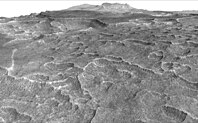



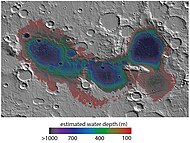
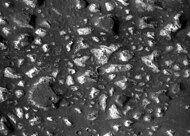



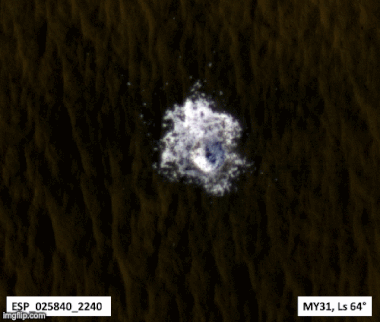
![Close view of wall of triangular depression, as seen by HiRISE layers are visible in the wall. These layers contain ice. The lower layers are tilted, while layers near the surface are more or less horizontal. Such an arrangement of layers is called an "angular unconformity".[269][full citation needed]](http://upload.wikimedia.org/wikipedia/commons/thumb/7/7e/50345_1230icelayersangular.jpg/380px-50345_1230icelayersangular.jpg)


